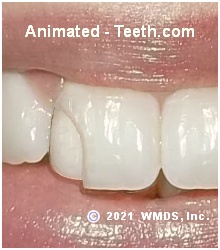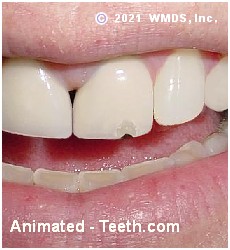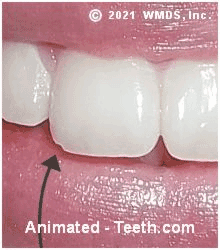Repair options for lost or broken porcelain veneers.
Is porcelain veneer repair possible?
The potential for repairing a veneer will depend on precisely what type of damage or event has taken place. (Our page “Handling porcelain veneer emergencies” can help you understand what type of event has occurred.)
The following list outlines some of the most common types of problems that occur and their solutions. The remainder of this page then explains each scenario in greater detail.
Possible repairs for lost or broken porcelain veneers.
- If your veneer has come off in one piece, it’s likely that reattachment is possible.
- In cases where a substantial portion of a veneer has come off, or an intact veneer that debonded has since broken, there’s generally no appropriate repair possible. A new veneer will need to be made.
- If a very minor portion of a veneer has broken off, it may be possible for your dentist to make a patch. However, there are issues and concerns associated with doing so. Remaking the veneer offers the superior solution.
- A cracked veneer that stays attached to its tooth, at minimum, requires regular evaluation. It’s usually best to go ahead and make plans for its replacement.
- If a veneer has experienced very minute chipping (like off the restoration’s biting edge), your dentist may be able to make an acceptable repair by polishing the defect out.
The remainder of this page provides a more detailed discussion about the above points.
Possible porcelain veneer repair options –
a) Can a porcelain veneer that’s come off be reattached?
If a porcelain laminate has simply debonded (has come off your tooth but is still in one piece), your dentist may be able to reattach it.
This veneer debonded but luckily remained intact.

Reattachment will be possible.
The usual scenario.
The success of the repair will be influenced by –
- How successfully the veneer’s internal porcelain surface (now coated with bonding from the initial attachment) can be renewed for the re-bonding process.
- How ideal the tooth’s surface is for having a veneer placed.
We explain more about these issues below.
1) Ideal protocol for rebonding a porcelain veneer.
In light of the most common scenario (the layer of cement has remained attached to the internal surface of the lost restoration), the preferred protocol for reconditioning a veneer involves placing it in a 650 degree F furnace for one minute. This process is used to pyrolyze (decompose via high-heat) or burn off the retained layer of dental bonding.
The veneer’s cleansed internal surface can then be reconditioned (etched), in similar fashion as to when it was originally made, and then (re)bonded to its tooth. Under this (ideal) scenario, the outlook for the reattached veneer should be on par as to when it was originally placed.
▲ Section references – Roman-Rodriguez
2) Alternative approaches.
In lieu of using the protocol above, some dentists may choose to …
- Simply rebond the veneer without first extensively reconditioning its internal porcelain surface.
- Or cement the veneer back into place using some type of dental adhesive.
(With this scenario, the restoration is held in place via the adhesive properties of the cement. This is different from the technique (bonding science)that was used to attach it originally.)
FYI: For those of you wondering right about now, here’s a related page you might find of interest: Can you just cement your lost veneer back on with super glue?
In cases where an alternative approach is recommended, you’ll simply need to ask your dentist about their rationale in making this decision. From a practical standpoint, there may be reasons why this type of repair might be worth a try, or even make reasonable sense. But because perfectly ideal conditions aren’t likely to be met, the repair attempt may be subpar.
3) A new restoration may be recommended.
As a reality check, it’s important to understand that a veneer may have come off because ideal conditions for its placement didn’t exist originally. (A tip-off might be that you have experienced its debonding before.)
This scenario isn’t terribly uncommon. As we discuss here, a recent trend in dentistry has been one where dentists and manufacturers have pushed the use of veneers to remedy conditions that far exceed the original applications for this procedure. This includes: a) “Instant” orthodontics for severely misaligned teeth, b) Lightening very dark teeth.
Now, with the lost veneer off, the deficiencies and challenges associated with the current veneer may become more obvious. And if so, the dentist must decide how best to overcome them.
New restoration options.
- Your dentist may feel that making a new veneer will offer an opportunity to make substantial improvements over the old one.
- Or instead, and especially with the advantage of hindsight, determine that placing a different type of restoration altogether, such as a dental crown, makes the better plan. (Related: Veneers vs Crowns, what’s the difference?)
(This recommendation might be based on the fact that it’s now apparent to the dentist that sections of the tooth’s surface, comprised of filling material or dentin as opposed to enamel, prevent an ideal (tenacious) bond from being created.)
While more expensive and time-consuming, making a new restoration may offer a much more predictable and lasting outcome.
A broken porcelain veneer.

No appropriate repair option really exists.
b) Can a broken porcelain veneer be repaired?
1) Repairs for large fractures.
a) Can’t the broken pieces just be reattached to the tooth?
Yes, the broken pieces of a veneer might be rejuvenated as described above and then rebonded. But the crack where the pieces of porcelain abut (come together) will create a problematic configuration that can’t be overcome. As examples:
- The crack between parts may fill in with bonding during the repair process. If so, it will probably show. Even if it doesn’t, the bonding can be expected to pick up stain, and therefore become more obvious, over time.
- If bonding doesn’t happen to fill in between the pieces, and even if the resulting repair looks reasonable at first, debris and discoloration can be expected to accumulate in the (unfilled) joint over time.
Worse, bacteria can accumulate in the crack and possibly even leak underneath the restoration, thus leading to the formation of tooth decay or chronic gum tissue irritation.
b) Can a filling be placed where the veneer has broken away?
Yes, that is a possible approach. And doing so probably isn’t all that uncommon. But this type of repair can’t offer a very satisfactory outcome, for a number of reasons.
- While not impossible, it can be difficult to create a bond between the dental composite (white filling material) that’s added and the porcelain veneer still attached to the tooth. A common scenario is one where a suitable bond is not created and therefore the filling does not have adequate retention (dislodges fairly easily).
Additionally, if an adequate bond isn’t created, there would always be concerns about restoration leakage. (A process where bacteria are able to seep underneath a dental restoration.)
- Composite filling material is a plastic compound, not porcelain. The norm is that composite will pick up stain and discoloration over time, whereas the porcelain covered aspect of your tooth will not, thus making the part of your tooth that’s a filling obvious.
- Because it’s plastic, dental composite won’t resist wear as well as porcelain. Over time, the uneven wear rate of the two materials will cause tooth, and probably smile, asymmetry.
- Because the light-handling characteristics of plastic and porcelain are different, creating a result for your tooth that looks acceptable may be difficult.
For all of these reasons, placing a filling to repair a broken porcelain veneer should be considered patchwork. That’s not to say that there aren’t situations where a patch, especially one that can be placed quickly, easily and comparatively inexpensively, can’t serve an important purpose.
But this type of repair shouldn’t be considered a permanent one. You should go ahead and make future plans for your veneer’s replacement.
2) Repairs for small veneer fractures and defects.
The sad news here, just like with larger porcelain fractures, is that no appropriate repair option (lasting, durable, predictable, exceptionally esthetic) really exists.
(Even if there was any potential for making some type of porcelain repair, it would have to involve the use of a high-heat furnace, which of course can’t be accomplished with a restoration that’s bonded to your tooth.)
Plans should be made to replace the damaged veneer.
Can’t a filling just be placed instead?
It may be possible for your dentist to create a patch with dental composite (white filling materia), in similar fashion as just discussed above. But all of the same problems mentioned in that section will come into play with this smaller type of repair too. As a recap of concerns, and specifically in regard to less extensive defects, here are some points to know.
- Your tooth’s laminate is made out of porcelain but the only material your dentist has to make a repair with is plastic (dental bonding/dental composite).
That means that even if the repair looks satisfactory initially (which it may), over the long haul (months and years) the less durable bonding material will deteriorate (pick up stain, chip and fleck off at the junction with the porcelain) and a distinction between the filling placed and the veneer will become obvious.
Even with small chips, no appropriate repair really exists.

- While not impossible, it can be a challenge for a dentist to create a suitable bond between the dental composite they’re adding and the tooth’s porcelain surface.
With chip repairs located in areas where substantial forces are involved, like the biting edges of teeth (see picture), the (reduced) strength of this bond may prove to be troublesome, with the repair being comparatively easy to dislodge.
- Since bonding to porcelain can be problematic, with a patch, especially one repairing a defect at the gum line edge of a veneer, there will always be a question if the filling placed creates an adequate seal for the tooth. (Meaning a barrier that prevents bacteria from leaking underneath the restoration.)
Since restoration leakage can result in the formation of tooth decay or gum tissue irritation, any patch that’s considered must be located on a portion of the tooth that can be readily monitored over time.
- Because dental composite and porcelain are entirely different materials, they have different optical properties too. In some cases, it can be difficult for a dentist to make a repair that has proper esthetics.
For these reasons, placing a filling to repair a broken porcelain veneer can only be considered patchwork. That’s not to say that there aren’t situations where a patch, especially one that can be placed quickly, easily and comparatively inexpensively, can’t serve an important purpose.
But this type of repair shouldn’t be considered a permanent one. You should go ahead and make future plans for your veneer’s replacement.
3) Cracks that form in veneers.
It’s possible for cracks or craze lines to form in a veneer but otherwise remain whole and in place on its tooth.
When this occurs, it’s impossible for a dentist to know how firmly the fractured parts are still attached to your tooth. Additionally, over time the crack will tend to accumulate stain, ultimately spoiling the veneer’s appearance.
There really isn’t any type of repair that can be made for this type of situation. There’s no way for your dentist to fill in the crack or bond the two pieces of porcelain back together. You’ll simply need to make plans to have a new veneer made.
Notice how performing the trimming results in a shape change for the tooth.

This change may or may not be a problematic issue.
4) Solutions for very minor veneer chipping.
One last word about replacement vs repair.
We hope you’ve noticed that except for the situation where a veneer has come off and can be properly prepared for rebonding, or the case where just very minor chipping has occurred, the most predictable, and likely most esthetic, outcome for a damaged porcelain veneer usually involves replacing it.
The hard, durable surface that a porcelain laminate creates for a tooth also poses significant limitations for your dentist when making any attempt to repair it. So in the case where your dentist advises you that it’s time to place a new restoration (whether that’s a veneer or possibly even a crown), it’s probably for very good reason and you will reap the benefits (predictability, durability, longevity and superior esthetics) of accepting that recommendation.
Page references sources:
Roman-Rodriguez JL, et al. Cleaning and retreatment protocol for a debonded ceramic restoration.
All reference sources for topic Porcelain Veneers.